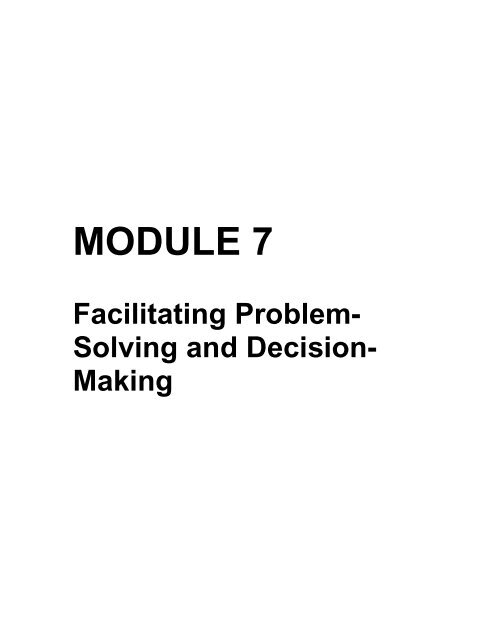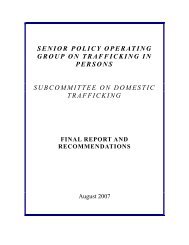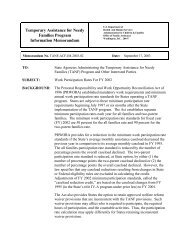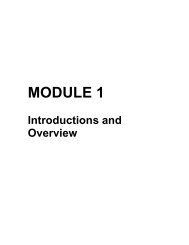Facilitating Problem-Solving and Decision-Making
Facilitating Problem-Solving and Decision-Making
Facilitating Problem-Solving and Decision-Making
Create successful ePaper yourself
Turn your PDF publications into a flip-book with our unique Google optimized e-Paper software.
MODULE 7<strong>Facilitating</strong> <strong>Problem</strong>-<strong>Solving</strong> <strong>and</strong> <strong>Decision</strong>-<strong>Making</strong>
Facilitation Skills for Child Support Enforcement StaffFacilitator GuideTRAINING NOTESWhat you need to know1. It will take approximately 1½ hours to complete the following topics in thismodule.TOPICModule OverviewThe Creative ProcessTools <strong>and</strong> TechniquesExercise: Dotmocracy<strong>Decision</strong>-<strong>Making</strong> MethodsChoosing the Best <strong>Decision</strong>-<strong>Making</strong> MethodExercise: How Would You Make the <strong>Decision</strong>?Module 7 Key PointsExercise: Reflection2. The equipment <strong>and</strong> supplies you will need for this module are listed below:• Computer projection system <strong>and</strong> screen• PowerPoint slides 7-1 through 7-10• Small size Post-It notes• Avery Dots—five per participant for use in the Dotmocracy exercise• Flipchart easels with pads of paper• Colored markers• Masking tape• Facilitator Guide• Participant Guides.Module 7: <strong>Facilitating</strong> <strong>Problem</strong>-<strong>Solving</strong> <strong>and</strong> <strong>Decision</strong>-<strong>Making</strong> 7-1
Facilitator GuideFacilitation Skills for Child Support Enforcement StaffTRAINING NOTESWhat you need to say/doMODULE OVERVIEW1. Tell the participants that so far in the workshop we have focused on the skills<strong>and</strong> knowledge that help them become more effective facilitators.2. Show slide 7-1, Facilitation Model. Explain that these skills <strong>and</strong> knowledgecan be applied to a variety of situations. This module will introduce them to anumber of tools <strong>and</strong> techniques that can help them when they are insituations that require problem-solving <strong>and</strong> decision-making—such as workgroups <strong>and</strong> project teams. Tell them that the next module will provideinformation on other facilitation situations.3. Tell them that the learning goal for Module 7 is to identify the tools <strong>and</strong>techniques that encourage groups to be more creative when they are chargedwith solving today’s complex problems <strong>and</strong> making decisions.4. Show slide 7-2, Module 7 Objectives. Review the objectives.• Through brief demonstrations, you will examine a set of problem-solvingtools <strong>and</strong> techniques.• After a lecture, you will identify three methods for making decisions.• Through a small group activity, you will apply guidelines to choose theappropriate decision-making method.5. Show slide 7-3, Einstein Quote. Read the quotation aloud to theparticipants. Ask the participants to turn to the person sitting to their right <strong>and</strong>take 2 minutes to discuss how the quote relates to their role as facilitators.6. After the discussion, have several volunteers share how they think Einstein’squote applies to them as facilitators.7. Point out that in order for some groups to meet their desired outcomes, theymust become more creative in the way they approach solving problems <strong>and</strong>making decisions. They can help groups achieve the desired outcomes byengaging them in the creative process.7-2 Module 7: <strong>Facilitating</strong> <strong>Problem</strong>-<strong>Solving</strong> <strong>and</strong> <strong>Decision</strong>-<strong>Making</strong>
Facilitation Skills for Child Support Enforcement StaffParticipant Guide PageMODULE 7: FACILITATING PROBLEM-SOLVING ANDDECISION-MAKINGFACILITATION MODEL7-1Learning GoalThe learning goal is to identify the tools <strong>and</strong> techniques that encourage creativity<strong>and</strong> help groups to achieve problem-solving <strong>and</strong> decision-making outcomes.You will use these tools <strong>and</strong> techniques along with your facilitation skills to workwith groups which are charged with solving problems <strong>and</strong> making decisions.MODULE 7 OBJECTIVES• Examine a set of problem-solvingtools <strong>and</strong> techniques• Identify three methods formaking decisions• Apply guidelines to choose theappropriate decision-makingmethod7-2Learning Objectives• Through demonstrations, you will examine a set of problem-solving tools <strong>and</strong>techniques.• After a brief lecture, you will identify the three methods for making decisions.• Through a small group activity, you will apply guidelines to choose theappropriate decision-making method.(Participant Guide 7-1)Module 7: <strong>Facilitating</strong> <strong>Problem</strong>-<strong>Solving</strong> <strong>and</strong> <strong>Decision</strong>-<strong>Making</strong> 7-3
Facilitator GuideFacilitation Skills for Child Support Enforcement Staff(This page is left intentionally blank.)7-4 Module 7: <strong>Facilitating</strong> <strong>Problem</strong>-<strong>Solving</strong> <strong>and</strong> <strong>Decision</strong>-<strong>Making</strong>
Facilitation Skills for Child Support Enforcement StaffParticipant Guide PageMODULE 7: FACILITATING PROBLEM-SOLVING ANDDECISION-MAKING, CONTINUEDEINSTEIN QUOTE“The significant problems we face cannotbe solved at the same level of thinking wewere at when we created them.”—Albert Einstein7-3(Participant Guide 7-2)Module 7: <strong>Facilitating</strong> <strong>Problem</strong>-<strong>Solving</strong> <strong>and</strong> <strong>Decision</strong>-<strong>Making</strong> 7-5
Facilitator GuideFacilitation Skills for Child Support Enforcement StaffTRAINING NOTESWhat you need to say/doTHE CREATIVE PROCESS1. Show slide 7-4, The Creative Process. Tell the participants that the creativeprocess involves alternating between two types of thinking.• The first type of thinking helps us to generate <strong>and</strong> exp<strong>and</strong> on ideas ordata.• The second type of thinking helps us to narrow the list.2. Explain that by repeatedly alternating between the two types of thinking, wecan ultimately prioritize <strong>and</strong> select items.3. State that there are simple yet powerful tools that help move a group throughthis creative process.4. Explain that we will look at three tools that are particularly helpful whengroups are charged with solving problems <strong>and</strong> making decisions.TOOLS AND TECHNIQUES1. Show slide 7-5, Tools & Techniques: Brainstorming. Tell the participantsthat brainstorming is a simple tool that is used to generate ideas <strong>and</strong> exp<strong>and</strong>options for a group to consider. It is one of the most, if not the most,frequently used facilitation tools. Use this tool when:• Many ideas are needed in a short period of time• Group input is important• Ideas/data need to be generated prior to using other tools.2. Refer participants to page 7-4 in their Participant Guides. Ask them to take afew minutes to read the information on brainstorming.7-6 Module 7: <strong>Facilitating</strong> <strong>Problem</strong>-<strong>Solving</strong> <strong>and</strong> <strong>Decision</strong>-<strong>Making</strong>
Facilitation Skills for Child Support Enforcement StaffParticipant Guide PageTHE CREATIVE PROCESSTHE CREATIVEPROCESSGenerating/Exp<strong>and</strong>ingNarrowing/Selecting7-4The creative process involves alternating between two types of thinking:generating/exp<strong>and</strong>ing <strong>and</strong> narrowing/selecting.(Participant Guide 7-3)Module 7: <strong>Facilitating</strong> <strong>Problem</strong>-<strong>Solving</strong> <strong>and</strong> <strong>Decision</strong>-<strong>Making</strong> 7-7
Facilitator GuideFacilitation Skills for Child Support Enforcement Staff(This page is left intentionally blank.)7-8 Module 7: <strong>Facilitating</strong> <strong>Problem</strong>-<strong>Solving</strong> <strong>and</strong> <strong>Decision</strong>-<strong>Making</strong>
Facilitator GuideFacilitation Skills for Child Support Enforcement StaffTRAINING NOTESWhat you need to say/doTOOLS AND TECHNIQUES, CONTINUED3. Explain that you will use a “fun” topic to demonstrate how to facilitate abrainstorming session. Tell them that they will brainstorm ideas about whypeople are late for work.(Note: If there are experienced facilitators in the group, consider asking oneof them to demonstrate facilitating this brainstorming session.)4. Write “Why are people late for work?” on the flipchart.5. Review the ground rules <strong>and</strong> explain that the brainstorming session will last5 minutes or until the group runs out of ideas.6. Conduct the brainstorming session.7. Show slide 7-6, Tools & Techniques: Nominal Group Technique. Tellthe participants that the nominal group technique is related to brainstorming.Use this tool when you want to:• Ensure involvement from everyone, especially if there are those who areuncomfortable or reluctant to express themselves.• Communicate the expectation that there will be equal participation. This isparticularly important when a “boss” is part of the group.8. Explain that you will not demonstrate this tool but would like them to read theinformation on page 7-5 in their Participant Guides. Ask them to take a fewminutes to read the information on how the nominal group technique works.What you need to know1. The brainstorming demonstration should take approximately 5 to 7 minutes.Save the flipchart pages for the Dotmocracy activity.7-10 Module 7: <strong>Facilitating</strong> <strong>Problem</strong>-<strong>Solving</strong> <strong>and</strong> <strong>Decision</strong>-<strong>Making</strong>
Facilitator GuideFacilitation Skills for Child Support Enforcement StaffTRAINING NOTESWhat you need to say/doTOOLS AND TECHNIQUES, CONTINUED9. Tell the participants that once groups have used brainstorming <strong>and</strong>/or thenominal group technique to generate <strong>and</strong> exp<strong>and</strong> ideas, they are now readyto move on to the second step in the creative process.10. Show slide 7-7, Tools & Techniques: Multivoting. Tell the participants thatmultivoting is a method for narrowing a list of ideas or options that a grouphas generated <strong>and</strong> can be used to prioritize <strong>and</strong> select from those options.Multivoting uses a point system in which participants allocate their points(votes) to one or more of the ideas that have been generated.11. Refer participants to page 7-6 in their Participant Guides. Tell them to take1 minute to read the information on multivoting; then they will practicemultivoting in an exercise called “Dotmocracy.”EXERCISE: DOTMOCRACY1. Distribute five Avery Dots to each participant.2. Refer to the posted flipchart pages of brainstormed ideas on why people arelate for work. Tell the participants that in a moment they will vote for the topfive reasons why people are late for work. They will do this by placing theirAvery Dots next to the idea or ideas on the flipchart pages.3. Remind them that each dot represents one vote. They may place all fiveAvery Dots next to one item or distribute the dots among several ideas.4. Have the participants come up to the flipcharts <strong>and</strong> vote.What you need to know1. The Dotmocracy exercise will take approximately 5 to 10 minutes. It isintended to be a fun <strong>and</strong> energizing activity. Don’t allow people to come up tothe flipchart one at a time to vote. Encourage people to come up at the sametime—a little bit of chaos helps a group to “lighten up.”7-12 Module 7: <strong>Facilitating</strong> <strong>Problem</strong>-<strong>Solving</strong> <strong>and</strong> <strong>Decision</strong>-<strong>Making</strong>
Facilitator GuideFacilitation Skills for Child Support Enforcement StaffTRAINING NOTESWhat you need to say/doEXERCISE: DOTMOCRACY, CONTINUED5. After everyone has voted, tally the votes for each idea. Then circle the fiveitems that have the most votes. Explain that the group could continue tomultivote until only one option remained.6. Ask participants for their reactions to multivoting. Emphasize that it is a greatway to energize a group while getting important work done.7. Remind participants that multivoting is an important part of the creativeprocess <strong>and</strong> a fun technique that allows a group to rank or prioritize items <strong>and</strong>make decisions by voting.8. Tell the participants that the next part of the module will examine three othermethods for making decisions.DECISION-MAKING METHODS1. Show slide 7-8, <strong>Decision</strong>-<strong>Making</strong> Methods. Tell the participants that in agroup or team environment, there are several different options for makingdecisions. The three methods you will discuss are:• Leader-led (or individual);• Consultative; <strong>and</strong>• Consensus.2. Explain that while team decisions can be of higher quality than individualdecisions, competent decisions do not always require the efforts of an entireteam. Also, each method has its share of advantages <strong>and</strong> disadvantages.3. Refer participants to pages 7-8 through 7-10 in their Participant Guides. Askthem to read the information provided on the three decision-making methods<strong>and</strong> the advantages <strong>and</strong> disadvantages of each.7-14 Module 7: <strong>Facilitating</strong> <strong>Problem</strong>-<strong>Solving</strong> <strong>and</strong> <strong>Decision</strong>-<strong>Making</strong>
Facilitation Skills for Child Support Enforcement StaffParticipant Guide PageDECISION-MAKING METHODSDECISION-MAKINGMETHODS• Leader-led (or individual)• Consultative• Consensus7-8In a group or team environment, there are several different options for makingdecisions. Three common methods are:• Leader-led (or individual);• Consultative; <strong>and</strong>• Consensus.While team decisions can be of higher quality than individual decisions,competent decisions do not always require the efforts of an entire team. Also,each method has its share of advantages <strong>and</strong> disadvantages.(Participant Guide 7-7)Module 7: <strong>Facilitating</strong> <strong>Problem</strong>-<strong>Solving</strong> <strong>and</strong> <strong>Decision</strong>-<strong>Making</strong> 7-15
Facilitation Skills for Child Support Enforcement StaffParticipant Guide PageDECISION-MAKING METHODS: LEADER-LEDAdvantages• Is fast <strong>and</strong> efficient• Doesn’t need to spend time involving othersDisadvantages• Doesn’t tap group knowledge, experience, <strong>and</strong> creativity• Doesn’t build acceptance or “buy-in”• May create resentment, low morale, or reduced team effectiveness• May result in poor, relatively “uninformed” decisionsAppropriate Situations• Minor or routine decisions• Emergency situations• When a leader has all the necessary information <strong>and</strong> “buy-in” is not a concern(Participant Guide 7-8)Module 7: <strong>Facilitating</strong> <strong>Problem</strong>-<strong>Solving</strong> <strong>and</strong> <strong>Decision</strong>-<strong>Making</strong> 7-17
Facilitator GuideFacilitation Skills for Child Support Enforcement Staff(This page is left intentionally blank.)7-18 Module 7: <strong>Facilitating</strong> <strong>Problem</strong>-<strong>Solving</strong> <strong>and</strong> <strong>Decision</strong>-<strong>Making</strong>
Facilitation Skills for Child Support Enforcement StaffParticipant Guide PageDECISION-MAKING METHODS: CONSULTATIVEA leader gets input from individuals or the group before making a decision. Thiscan come in the form of information, suggestions, or advice. It is important toremember that even though the leader is collecting information from otherindividuals, he or she retains the responsibility for making the final decision.Advantages• Taps others’ knowledge, experience, <strong>and</strong> creativity• Gains some of the benefits of team discussion• May result in better, more informed decisionsDisadvantages• Requires more time <strong>and</strong> resources than the leader-led method• May not build acceptance or “buy-in” for implementing a decision• Does not allow for the resolution of conflict or controversies among teammembers• May result in power struggles among subordinates or group members as theyvie to influence the leader(Participant Guide 7-9)Module 7: <strong>Facilitating</strong> <strong>Problem</strong>-<strong>Solving</strong> <strong>and</strong> <strong>Decision</strong>-<strong>Making</strong> 7-19
Facilitator GuideFacilitation Skills for Child Support Enforcement Staff(This page is left intentionally blank.)7-20 Module 7: <strong>Facilitating</strong> <strong>Problem</strong>-<strong>Solving</strong> <strong>and</strong> <strong>Decision</strong>-<strong>Making</strong>
Facilitation Skills for Child Support Enforcement StaffParticipant Guide PageDECISION-MAKING METHODS: CONSENSUSThis is purely a group (or team) decision-making method. It typically involvesthree features:• Each group member participates in discussing the issue• The group mutually decides what to do• The final decision must be one that everyone can accept <strong>and</strong> support; everymember must consent before the decision is adopted.Advantages• Synergy—tapping into others’ knowledge, experience, <strong>and</strong> creativity, whichresults in higher quality decisions• Maximized interaction• Discussion <strong>and</strong> challenge of all ideas• Less emphasis on assumptions <strong>and</strong> more emphasis on fact• Opportunity to resolve conflicts• Strong acceptance <strong>and</strong> support for decisions, which promote commitment toimplement• Enhancement of future decision-making ability of the team• Opportunity to build <strong>and</strong> strengthen the team; trustDisadvantages• Time consuming• May require a great deal of skill <strong>and</strong> psychological energy• Sometimes impossible to get everyone to agree• Leader may lack communication <strong>and</strong> facilitation skills needed to steer thegroup toward consensus(Participant Guide 7-10)Module 7: <strong>Facilitating</strong> <strong>Problem</strong>-<strong>Solving</strong> <strong>and</strong> <strong>Decision</strong>-<strong>Making</strong> 7-21
Facilitator GuideFacilitation Skills for Child Support Enforcement StaffTRAINING NOTESWhat you need to say/doCHOOSING THE BEST DECISION-MAKING METHOD1. Show slide 7-9, Choosing the Best <strong>Decision</strong>-<strong>Making</strong> Method. Tellparticipants that quality, information, time, <strong>and</strong> acceptance are factors thatneed to be considered when deciding which of the decision-making methodsto use. It is helpful to ask a series of diagnostic questions. The answers tothese questions will indicate which method should be used. These questionsare:• How important is the decision?• Does the leader have enough information?• Is it clear what information is needed <strong>and</strong> where to get it?• Is time a constraint?• How likely are other people in the group or organization to accept thedecision?• How likely is conflict over possible solutions?2. Refer participants to page 7-12 in their Participant Guides. Tell them that thefactors <strong>and</strong> related questions serve as guidelines to help them to choose thebest decision-making method.3. Tell the participants that the next exercise will give them an opportunity toapply the guidelines to decision-making situations described in three casestudies.7-22 Module 7: <strong>Facilitating</strong> <strong>Problem</strong>-<strong>Solving</strong> <strong>and</strong> <strong>Decision</strong>-<strong>Making</strong>
Facilitation Skills for Child Support Enforcement StaffParticipant Guide PageCHOOSING THE BEST DECISION-MAKING METHODCHOOSING THE BESTDECISION-MAKINGMETHOD• How important is the decision?• Is there enough information?• What information is needed <strong>and</strong> do youknow where to get it?• How much time is available?• Will group/organization accept decision?• How likely is conflict over solutions?7-9(Participant Guide 7-11)Module 7: <strong>Facilitating</strong> <strong>Problem</strong>-<strong>Solving</strong> <strong>and</strong> <strong>Decision</strong>-<strong>Making</strong> 7-23
Facilitator GuideFacilitation Skills for Child Support Enforcement Staff(This page is left intentionally blank.)7-24 Module 7: <strong>Facilitating</strong> <strong>Problem</strong>-<strong>Solving</strong> <strong>and</strong> <strong>Decision</strong>-<strong>Making</strong>
Facilitation Skills for Child Support Enforcement StaffParticipant Guide PageCHOOSING THE BEST DECISION-MAKING METHODFACTOR QUESTION TO ASK METHOD TO CONSIDERImportance of decisionLeader’s information <strong>and</strong>expertiseInformation neededIs a high quality decisionessential?Does the leader haveenough information tomake a high qualitydecision?Is it clear whatinformation is needed<strong>and</strong> where to get it?Y: consensusN: leader-led, consultativeY: leader-ledN: consultative, consensusY: leader-led, consultativeN: consensusTime constraints Is enough time available? Y: consensus, consultativeN: leader-ledImportance ofacceptance by people ingroup or organizationLikelihood the group willaccept leader’s decisionenthusiasticallyLikelihood of conflictIs acceptance by allmembers of the group ororganization critical?If leader makes thedecision, are othergroups members likely toaccept it enthusiastically?Are group members likelyto favor conflictingsolutions?Y: consensus, consultativeN: leader-ledY: leader-ledN: consensus, consultativeY: consensusN: leader-led, consultative(Participant Guide 7-12)Module 7: <strong>Facilitating</strong> <strong>Problem</strong>-<strong>Solving</strong> <strong>and</strong> <strong>Decision</strong>-<strong>Making</strong> 7-25
Facilitator GuideFacilitation Skills for Child Support Enforcement StaffTRAINING NOTESWhat you need to say/doEXERCISE: HOW WOULD YOU MAKE THE DECISION?1. Refer participants to page 7-13 in their Participant Guides. Ask them to readthe instructions. Answer any questions they may have about the exercise.2. Have participants form two groups of four to six persons each.3. Assign one group case study #1 <strong>and</strong> the other group case study #2. Explainthat each group is to read all cases, but only complete the case assigned totheir group. Tell them they will need to choose a spokesperson to report outthe answer for their case study <strong>and</strong> their rationale.4. Tell them that if there is time, both groups will complete case study #3.5. Tell the participants to use the guidelines on Choosing the Best <strong>Decision</strong>-<strong>Making</strong> Method on page 7-12 in their Participant Guides.6. Tell the participants they have 10 minutes to work in their groups to completethe exercise.7. After 10 minutes, ask the spokesperson for Case 1 to share the group’sanswer <strong>and</strong> the rationale. Provide the recommended answer <strong>and</strong> facilitate alarge group discussion of why that method was chosen.8. Repeat the process for Case 2. Complete Case 3, if time permits.9. Reiterate that the answers provided are recommendations. The guidelinesthey use to choose the most appropriate decision-making method are justthat—guidelines <strong>and</strong> not hard-<strong>and</strong>-fast rules. Ultimately, participants mustexercise their best judgment in each situation.What you need to know1. The exercise on choosing the best decision-making method takesapproximately 20 minutes. Allow 10 minutes for small group work <strong>and</strong> 10minutes for the spokepersons to share their answers <strong>and</strong> rationale <strong>and</strong> forlarge group discussions.2. The recommended answer <strong>and</strong> rationale for each case study are located inthe appendix to this module. Link the answers to the specific decision-makingmethod.7-26 Module 7: <strong>Facilitating</strong> <strong>Problem</strong>-<strong>Solving</strong> <strong>and</strong> <strong>Decision</strong>-<strong>Making</strong>
Facilitator GuideFacilitation Skills for Child Support Enforcement Staff(This page is left intentionally blank.)7-28 Module 7: <strong>Facilitating</strong> <strong>Problem</strong>-<strong>Solving</strong> <strong>and</strong> <strong>Decision</strong>-<strong>Making</strong>
Facilitation Skills for Child Support Enforcement StaffParticipant Guide PageEXERCISE: HOW WOULD YOU MAKE THE DECISION?,CONTINUEDCASE 1You are a director of a large child support enforcement agency. Your agencyhas done well under your leadership <strong>and</strong> your four managers hold you in highesteem. You appreciate that, but you know that your success is based mostly onsimple hard work <strong>and</strong> a few good decisions. Lately, you feel that your managersare becoming increasingly dependent upon you <strong>and</strong> rely too much on yourjudgment.Nine months from now, an additional site will be added to the already existingsatellite offices so that the agency can better serve its clients. You are todetermine the best location for the new site. Your managers will have to supportthe site in “concrete” ways, not just in attitude. The staff of this new site willcome from among the staff of the existing units, <strong>and</strong> the existing units will providetechnical assistance <strong>and</strong> support, at least for a little while.You have asked each manager to develop a list of possible locations withinformation explaining why each location would be good <strong>and</strong> what problemsmight be present. To decide where to locate the new site, you will:A. Talk to each manager privately, reviewing in particular the locationscommon to the four lists to get enough information to make your finaldecision.B. Review the lists <strong>and</strong> reasons; then make a decision.C. Call the managers together as a group to review their lists <strong>and</strong> fully discussthe options before they, as a group, make a final decision.D. Go over the set of lists with each manager <strong>and</strong> get each manager’s bestideas <strong>and</strong> evaluations; then you will take these into account when makingyour final decision.E. Meet with the managers as a group to share information, review their lists,<strong>and</strong> get their ideas <strong>and</strong> suggestions as a group; then you will take thisinformation into account when making your final decision.(Participant Guide 7-14)Module 7: <strong>Facilitating</strong> <strong>Problem</strong>-<strong>Solving</strong> <strong>and</strong> <strong>Decision</strong>-<strong>Making</strong> 7-29
Facilitator GuideFacilitation Skills for Child Support Enforcement Staff(This page is left intentionally blank.)7-30 Module 7: <strong>Facilitating</strong> <strong>Problem</strong>-<strong>Solving</strong> <strong>and</strong> <strong>Decision</strong>-<strong>Making</strong>
Facilitation Skills for Child Support Enforcement StaffParticipant Guide PageEXERCISE: HOW WOULD YOU MAKE THE DECISION?,CONTINUEDCASE 2You are the project manager of a group that provides technical support for thestatewide-automated child support enforcement system. You are responsible forinstalling additional computers <strong>and</strong> related hardware to bring people “on line” infive of the agency’s largest units. It is important to have a clear <strong>and</strong> accurateschedule so that equipment will arrive when it is needed.You have experience working on similar projects <strong>and</strong> have the technical <strong>and</strong>historical data needed to determine the earliest <strong>and</strong> latest times that theequipment will be needed. So it’s relatively simple to calculate the time at whichthe equipment needs to be delivered for each of the units.In preparing the schedule you will:A. Use your knowledge <strong>and</strong> data to set up a plan that will ensure equipment isavailable when needed <strong>and</strong> will be there a bit early if, as hoped, the projectcontinues to go a bit ahead of schedule.B. Meet with your staff <strong>and</strong> have them work out a schedule to encourage themto move the project ahead as fast as possible.C. Meet with each staff member individually to make sure your information <strong>and</strong>calculations are correct; then you will go ahead <strong>and</strong> set up the schedule.D. Call the staff together to review the information as a group <strong>and</strong> check out allthe data; then you will go ahead <strong>and</strong> set up the schedule.E. Meet with each supervisor alone to share the problem of developing theschedule <strong>and</strong> to get their ideas; then you will prepare the final scheduleyourself.(Participant Guide 7-15)Module 7: <strong>Facilitating</strong> <strong>Problem</strong>-<strong>Solving</strong> <strong>and</strong> <strong>Decision</strong>-<strong>Making</strong> 7-31
Facilitator GuideFacilitation Skills for Child Support Enforcement Staff(This page is left intentionally blank.)7-32 Module 7: <strong>Facilitating</strong> <strong>Problem</strong>-<strong>Solving</strong> <strong>and</strong> <strong>Decision</strong>-<strong>Making</strong>
Facilitation Skills for Child Support Enforcement StaffParticipant Guide PageEXERCISE: HOW WOULD YOU MAKE THE DECISION?,CONTINUEDCASE 3You have recently assumed the job of managing the technical training providedfor those who use the region’s automated child support enforcement system.Caseworkers are still experiencing difficulty using the system, <strong>and</strong> your first taskis to oversee the development of a new training program that will increase theirtechnical knowledge <strong>and</strong> skills. Your agency contracts out the training, <strong>and</strong> threevendors have submitted proposals for the work. Some of your staff have hadexperience with the vendors. You will therefore:A. Analyze the proposals you have received. Based on your underst<strong>and</strong>ing ofwhat needs to be done, what each vendor is proposing, what you knowabout each vendor, <strong>and</strong> the proposed costs, you will decide which vendor touse.B. Talk to the staff members who have had experience with the vendors youare considering to get as much information as possible. Then you will usethis information to make your decision.C. Ask each staff member individually for ideas or suggestions on which vendorto choose to develop the training. When you have talked with all of them,you will make your decision.D. Meet with the staff as a group to get their ideas <strong>and</strong> suggestions. Based onthis information, you will make your decision.E. Meet with the staff as a group to discuss the problem <strong>and</strong> have the groupdecide which vendor to go with.(Participant Guide 7-16)Module 7: <strong>Facilitating</strong> <strong>Problem</strong>-<strong>Solving</strong> <strong>and</strong> <strong>Decision</strong>-<strong>Making</strong> 7-33
Facilitator GuideFacilitation Skills for Child Support Enforcement StaffTRAINING NOTESWhat you need to say/doMODULE 7 KEY POINTS1. Show slide 7-10, Module 7 Key Points. Review the slide.• Many groups which are charged with solving problems <strong>and</strong> makingdecisions need to be more creative in order to achieve the desiredoutcomes. This is particularly important when faced with problems that arehighly complex <strong>and</strong> whose solutions will have significant consequences.• Effective facilitators use a variety of tools <strong>and</strong> techniques that involveparticipants <strong>and</strong> encourage a group’s creativity.• In solving problems <strong>and</strong> making decisions, a leader must consider variousfactors when choosing the most appropriate decision-making method.EXERCISE: REFLECTION1. Tell the participants that this final exercise will give them a chance to applythe guidelines for choosing a decision-making method to their own situations.2. Refer them to page 7-18 in their Participant Guides. Ask them to read theinstructions <strong>and</strong> ask if they have any questions.3. State that they have 10 minutes to individually complete the exercise. Thenyou will ask for volunteers to share their information.4. After 10 minutes, have several volunteers briefly explain the decision to bemade <strong>and</strong> which method they’ve determined is the most appropriate one <strong>and</strong>why.5. Close the module <strong>and</strong> transition to Module 8, <strong>Facilitating</strong> With Technology.What you need to know1. The Reflection exercise takes approximately 12 to 15 minutes.2. Make Post-It notes available for marking pages.7-34 Module 7: <strong>Facilitating</strong> <strong>Problem</strong>-<strong>Solving</strong> <strong>and</strong> <strong>Decision</strong>-<strong>Making</strong>
Facilitation Skills for Child Support Enforcement StaffParticipant Guide PageMODULE 7 KEY POINTSMODULE 7 KEY POINTS• A creative approach is needed to solvetoday’s problems <strong>and</strong> make decisions• There are tools <strong>and</strong> techniques thatfacilitate the creative process• There are numerous factors to considerwhen choosing the best decision-makingmethod7-10(Participant Guide 7-17)Module 7: <strong>Facilitating</strong> <strong>Problem</strong>-<strong>Solving</strong> <strong>and</strong> <strong>Decision</strong>-<strong>Making</strong> 7-35
Facilitator GuideFacilitation Skills for Child Support Enforcement Staff(This page is left intentionally blank.)7-36 Module 7: <strong>Facilitating</strong> <strong>Problem</strong>-<strong>Solving</strong> <strong>and</strong> <strong>Decision</strong>-<strong>Making</strong>
Facilitation Skills for Child Support Enforcement StaffParticipant Guide PageEXERCISE: REFLECTIONInstructions: Describe an upcoming situation in which a decision must be made.Identify the specific decision to be made. Then, using the guidelines on page7-12, determine which decision-making method is the most appropriate <strong>and</strong> why.1. What is the situation?2. What is the specific decision that is to be made?3. Which of the decision-making methods (leader-led, consultative, consensus)is most appropriate <strong>and</strong> why?(Participant Guide 7-18)Module 7: <strong>Facilitating</strong> <strong>Problem</strong>-<strong>Solving</strong> <strong>and</strong> <strong>Decision</strong>-<strong>Making</strong> 7-37
















